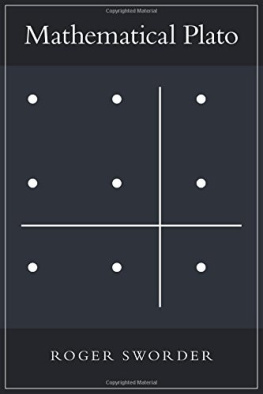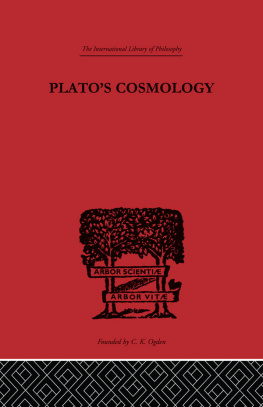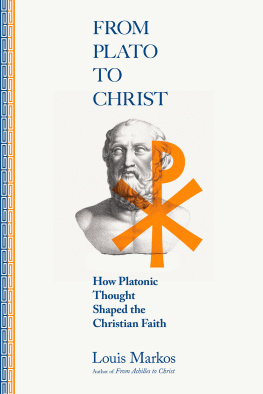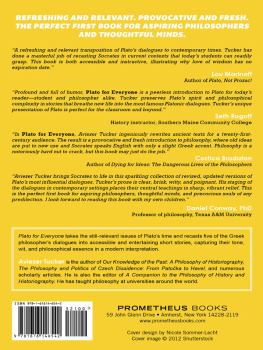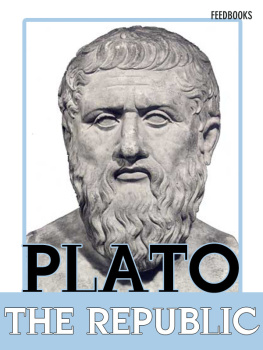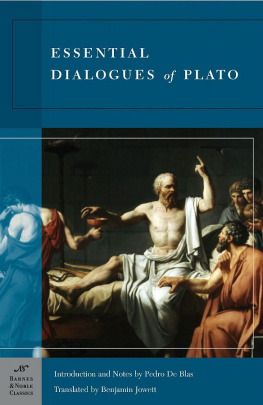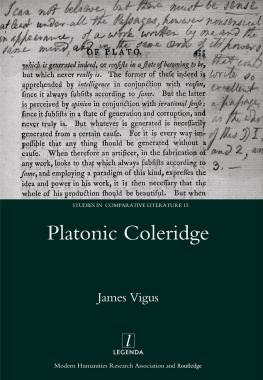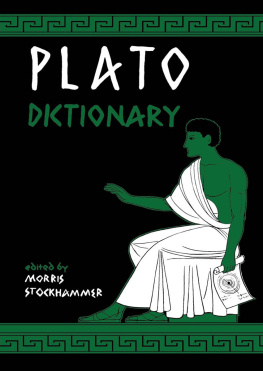
Roger Sworder
mathematical
p lat o
First published in the USA
by Angelico Press / Sophia Perennis
Roger Sworder 2013
All rights reserved
Series editor: James R. Wetmore
No part of this book may be reproduced or transmitted,
in any form or by any means, without permission
For information, address:
Angelico Press, 4619 Slayden Rd. NE
Tacoma, WA 98422
www.angelicopress.com
Library of Congress Cataloging-in-Publication Data
Sworder, Roger.
Mathematical Plato / Roger Sworder.First ed.
pages cm.
isbn 978-1-59731-138-0 (pbk: alk. paper)
1. Plato. 2. SciencePhilosophy.
3. MathematicsPhilosophy. 4. Ancient philosophy.
I. Title
b395.88 2013
184dc22
20130115688
Cover Design: Michael Schrauzer
contents
Preface ix
PART I: Philosophy of Mathematics & Natural Science
Platos Grand Theory 1
Recollection 12
The Divided Line 24
The Simile of the Cave 35
The Model of the Cosmos 43
PART II: Mathematics & Natural Science
The Divided Line Again 51
The Nuptial Number 57
Numbers of the World Soul 67
The Human Head and Face 83
PART III: Critique of Natural Science & Philosophy
10 Natural Science 89
11 Philosophy of Science 98
12 Music 107
13 Science as Worship 112
Acknowledgments
i am grateful to Professor Terry Mills for correcting some of the mathematics in my manuscript, and to Dr. Dorothy Avery for preparing it for publication.
Chapters 6, 7, and 9 appeared in earlier forms in A Contrary Historyof the West, and chapter 7 in Parmenides at Delphi.
viii
Preface
the title of this book is surely as unattractive at this time as a title can be. Plato himself has been at odds with his own institution since Francis Bacon. In our time he is the very paradigm of classist, sexist, and racist patriarchy. In those places where his books are still taught, there will always be students who sing to his poetry, but these are just the students who will be deterred by the other word of my title. Among Humanities students the distaste for mathematics is very widespread.
And yet according to its title at least, this book should be an Academic book of books, the quintessence of Western learning and the great goal of our enterprise. Plato founded the Academy and placed mathematics at the center of its work. He established as no one else the unbreakable connection between the natural and the mathematical sciences. This connection has never been stronger than it is now. The mathematical passages in his Dialogues are often
abstruse, and these passages are arguably the real core of his teaching, difficult precisely so as to draw out the full powers of the student.
There is one qualification which any reader of this book must meet. They must have copies of the Phaedo, the Republic, and the Timaeus. Very little of these texts appears in this book, but most of this book is a detailed and intricate study of Platos actual words. It is much easier to follow arguments about texts if the text itself is present to the eye simultaneously, and the easiest way to do this is to have both books open at the right pages. Any translation will serve, provided only that the reader has most confidence, for the moment, in the brief translations here of key passages.
ix
Mathematical Plato
For The School of Philosophy
Melbourne, Australia
x
Preface
PART I
MATHEMATICS and NATURAL SCIENCE
xi
Mathematical Plato
xii
Platos Grand Theory
in his dialogue the Parmenides Plato makes an extended attack on his own theory of ideas or forms. This theory is the basis of his psychology in the Phaedo, of his ideal state in the Republic and of the natural creation in his Timaeus. But his attack on this theory goes undefended and unanswered either in the Parmenides or elsewhere . The dating of these various dialogues is uncertain and so therefore are their temporal relations to each other. If the Parmenides was written after the others, then maybe Plato intended it to supersede them. In that case Platos intellectual career may be compared to Wittgensteins, who rejected the theory of language expounded in his early Tractatus for the different approach of the Philosophical Investigations. And from Gilbert Ryle onwards a number of Platonic scholars have supposed exactly this, that Plato changed his mind and became more of a linguistic analyst like themselves in his later years.
But even it if could be shown that the Parmenides was composed later than the works which depended on the theory of ideas, this would make no difference to the chronology or sequence in which Plato himself presents them. And in that sequence the Parmenides is clearly first, not last. The Phaedo presents Socrates at his death, the Republic and the Timaeus show him as mature, the Parmenides as very young indeed for serious discussion. But if the Socrates of the Phaedo, Republic and Timaeus still believes in the theory of ideas after the trouncing the young Socrates was given in the Parmenides, then Platos Socrates at least had no change of heart about the theory at depth, but continued to propound it to the end. That Plato did the same and held to the theory of ideas throughout his life was the unanimous view of antiquity.
Mathematical Plato
The Parmenides presents a great many arguments against the theory of ideas but there is one which has always attracted inordinate attention. I present it here in Cornfords translation. Parmenides is the questioner, Socrates the respondent:
How do you feel about this? I imagine your ground for believing in a single form in each case is this. When it seems to you that a number of things are large, there seems, I suppose, to be a certain single character which is the same when you look at them all, hence you think that largeness is a single thing.
True, he replied.
But now take largeness itself and the other things which are large.
Suppose you look at all these in the same way in your minds eye, will not yet another unity make its appearance a largeness by virtue of which they all appear large?
So it would seem.
If so, a second form of largeness will present itself, over and above largeness itself and the things that share in it, and again, covering all these, yet another, which will make all of them large. So each of your forms will no longer be one, but an indefinite number.1
And
Well, if a thing is made in the image of the form, can that form fail to be like the image of it, in so far as the image was made in its likeness? If a thing is like, must it not be like something that is like it?
It must.
And must not the thing which is like share with the thing that is like it in one and the same thing [character]?
Yes.
And will not that in which the like things share, so as to be alike, be just the form itself that you spoke of?
1. Parmenides 132 a.1b.3.
Platos Grand Theory
Certainly.
If so, nothing can be like the form, nor can the form be like anything. Otherwise a second form will always make its appearance over and above the first form, and if that second form is like anything, yet a third. And there will be no end to this emergence of fresh forms, if the form is to be like the thing that partakes of it.2
Next page
